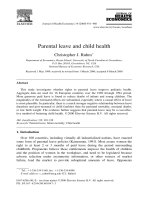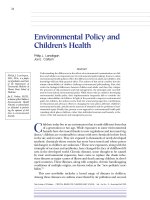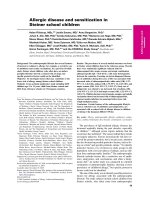Tài liệu CANCER, GENES AND INHERITED PREDISPOSITION OvERvIEw – Cancer Genetics pptx
Bạn đang xem bản rút gọn của tài liệu. Xem và tải ngay bản đầy đủ của tài liệu tại đây (416.92 KB, 5 trang )
www.genetics.edu.au The Australasian Genetics Resource Book – © 2007
1
What is cancer?
Each cell contains a copy of the genetic plan for our growth,
development and health. This genetic plan comes in the form
of the genes, located on chromosomes that we inherit from our
parents. The genes contain the information for the body to make
all the necessary structural components and chemicals to ensure
normal function.
There are two copies of every gene, one inherited from our
mother and one inherited from our father. For more information
on genes, see Genetics Fact Sheet 1.
As we go through life our cells are continually growing and
being replaced. New cells are formed from existing cells by a
process called cell division. Each time a cell divides it has to make
a copy of all of its contents, including its genes, so that the new
cells have the same genes or information as the old.
A number of different genes act together to instruct each cell
how to copy its genes properly, and how to divide and grow in a
controlled and orderly manner (ie. growth control genes). Different
growth control genes work in the cells of different organs and
tissues in the body ie. growth control genes that are active in the
cells of breast tissue may be different to growth control genes that
are active in the cells of the bowel.
Cancer occurs when cells in the body become abnormal
and grow out of control and they have the ability to spread
to other parts of the body (metastasise). Cancer is a result of
uncontrolled cell division and growth.
Uncontrolled cell division and growth leading to cancer
can occur in any tissue or organ in the body. Cancer is named
according to the place where it starts growing: for example, when
it occurs in the breast it is called breast cancer.
A group of cells that has resulted from uncontrolled cell
division and growth is called a tumour.
• Tumourscanbebenign (not cancer) or malignant (cancer)
• Metastatic cancer occurs when cancerous cells spread into other
surrounding tissues, or enter the circulatory system and travel
to other parts of the body, producing new tumours
CANCER, GENES AND INHERITED PREDISPOSITION OvERvIEw – Cancer Genetics 1
47
FACT SHEET
Produced by the Centre for Genetics Education. Internet:
Important points
• Afamilyhistoryofcancercanoccur:
– Just by chance, because cancer is common
– Because family members are exposed to the same environmental factors
– Because a predisposition to cancer is running in the family, though this is rare
• Weallhaveinourcellstwocopiesofanumberofdifferentgenesthatcontrolorderlygrowthanddivisionofourcells
throughout life (growth control genes)
• Whenthesegrowthcontrolgenesbecomefaultyincellsinaparticularpartofthebody,egbreasttissue,thecellsdivideand
grow out of control and accumulate to form a cancer
• Canceroccursasaresultofuncontrolledcelldivisionandgrowth.Thesegrowthcontrolgenescanthereforebethoughtof
normally acting as ‘cancer protection’ genes
• Allcancerscanbeconsideredgeneticinoriginbecausetheyarisefromchangesinthenormal‘cancerprotection’genesthat
we all have. A change in the information in a ‘cancer protection’ gene that makes the gene faulty is called a mutation
• Thecauseofthechangesthatmakethe‘cancerprotection’genefaultyisunknown,butmaybeduetoacombinationof
genetic factors, environmental factors, and the process of ageing
• Thedevelopmentofcancerisnotaquickorsimpleprocess.Itisaprogressioninvolvingabuild-upofchangesinanumberof
different ‘cancer protection’ genes in the cells of the body tissues over a lifespan. This is why the development of cancer can
take many, many years and is more often seen in older people
• Mostpeoplearebornhavingtwoworkingcopiesofeachofthedifferent‘cancerprotection’genesintheircells.Thismeans
that most people have not inherited a genetic predisposition to developing cancer
• Asmallnumberofpeopleinheritfromaparentachangeinoneofthecopiesofoneoftheir‘cancerprotection’genesthat
make the gene copy faulty. These people are carriers of a faulty ‘cancer protection’ gene and have inherited a predisposition to
develop cancer ie. are at increased risk
• Thepatternofinheritanceofpredispositiontocancerinthefamilycanbedifferentdependingonwhichgeneisinvolved
• Acarrierofafaulty‘cancerprotection’genemayneverdevelopcancerunlessothercancerprotectiongenesinthecell
becomefaultyoverthatindividual’slifetime.Ifcancerdoesdevelophowever,itmaytendtodosoearlierintheirlife.Forthe
same reason, new cancers can develop in more than one place in the body
• Ifsomeonedoesnotcarryafaulty‘cancerprotection’genetheystillhavethesamechanceofdevelopingcancerasanyoneelse
in the community
• Geneticcounsellingcanclarifyaindividual’sriskanddiscusstheiroptionsforgenetictesting,itslimitations,advantagesand
disadvantages and available prevention and early detection strategies
2
The Australasian Genetics Resource Book – © 2007 www.genetics.edu.au
‘Cancer protection’ genes
Since the growth control genes normally provide information
to prevent uncontrolled cell division, they can be thought of as
‘cancer protection’ genes. Weallhavetwocopiesofanumberof
different ‘cancer protection’ genes in our cells, one copy inherited
from our mother and one copy inherited from our father.
There are different types of ‘cancer protection’ genes:
• Tumour suppressor genes
• Genesthatactasthe‘brakes’onuncontrolledcellgrowth.
Cancer may occur when both copies of a tumour suppressor
gene (both ‘brakes’) fail to work properly
• Oncogenes
• Oncogenesaretheacceleratorsofcelldivision(ie.theyincrease
the rate of cell division). Cancer may occur when these genes
are switched on inappropriately (too much accelerator)
• Mismatch repair genes
• Thesearegenesthatareinvolvedinndingandrepairing
mistakes in the genetic information that can occur when the
genes are copied to make new cells. The mismatch repair gene
acts just like a ‘spell checker’ on the computer. Cancer may
occur when damage to these genes results in failure to repair
mistakes in the DNA
Another way of thinking about how these genes work in the cells
is to imagine that the genetic control of cell division is a car that is
working well (see Figure 47.1).
For the car to work, the mechanisms to make the car move
(the accelerator or oncogenes) and stop (the brakes or tumour
suppressor genes) must be in balance. Also the mismatch repair
genes are like the mechanic who keeps the car running smoothly.
Changes in the ‘cancer protection genes’
Ifachangeoccursintheinformationinoneofthese‘cancer
protection’ genes in a cell of a tissue or organ such as a breast or
bowel tissue, the prostate or skin, that cell’s division may be less
well controlled.
Some of these changes will make the gene unable to issue its
normal instructions for the cell to divide in an orderly manner ie.
the gene becomes faulty. A change that makes the gene faulty is
called a mutation (see Genetics Fact Sheets 4 & 5).
Cells that normally divide and grow in an orderly manner may
grow and divide abnormally when their ‘cancer protection’ genes
become faulty.
What role do faulty ‘cancer protection’ genes have in the
development of cancer?
The cycle of cell division and growth continues throughout the
lifespan. Changes (mutations) in the ‘cancer protection’ genes that
make them faulty and impair their ability to protect against cancer
can build up over this time.
All cancers can, therefore be considered genetic in origin
because they arise from accumulated changes in the normal
‘cancer protection’ genes that we all have in the cells of the tissues
of the body.
A normal cell does not become a cancerous cell just because
onecopyofone‘cancerprotection’genebecomesfaulty.Mutations
have to occur in a number of different ‘cancer protection’ genes in
a cell, building up over time, before that cell becomes cancerous.
Onewayofrepresentingthisprocessistothinkofthepathto
cancer as a staircase where the bottom of the staircase represents a
normal cell and the top a cancerous cell (Figure 47.2).
The steps of the staircase represent a progression of changes
that may occur in one or both copies of a number of different
‘cancer protection’ genes in a cell. Some of these changes will be
mutations that make the ‘cancer protection’ gene faulty.
So for a normal cell to become cancerous, the copies of a
number of different ‘cancer protection’ genes in the cell of a tissue
or organ must become faulty over time.
What causes mutations to build up in the ‘cancer protection’ genes
over our lives?
Research is continuing to more fully understand the cause of
specicchangesinthe‘cancerprotection’genesinthecells.
However it is clear that ageing and our environment play major
roles.
Figure 47.1: The balance of cell growth and division is maintained by the
‘cancer protection’ genes just like a well-maintained car.
Figure 47.2: Changes build up in the different ‘cancer protection’ genes in the
cells over time due to ageing and other environmental factors. Some of these
changes make the ‘cancer protection’ genes faulty. Each step on the staircase
to becoming cancerous cells represents a change in a copy of one of the many
‘cancer protection’ genes in the cells.
Oncogenes
Accelerate
Mismatch repair genes
Repairs keep the car running smoothly
Tumour
suppressor genes
Brake
CANCER
CELLS
NORMAL
CELLS
Changes to ‘cancer protection’
genes that make them faulty
(mutations) caused by ageing
and other (unknown)
environmental factors
Cells that have become
cancerous
No cancer but more
susceptible to becoming
cancerous
No cancer but more
susceptible to becoming
cancerous
No cancer
Normal cell growth
Cell growth out
of control
CANCER, GENES AND INHERITED PREDISPOSITION OvERvIEw – Cancer Genetics 1
47
FACT SHEET
www.genetics.edu.au The Australasian Genetics Resource Book – © 2007
3
• •
•
•
•
•
•
•
•
•
•
•
•
•
•
•
•
•
• •
• x
•
•
•
•
•
•
•
•
•
•
•
•
•
•
•
•
• x x x
x x
x
x
x
x
x
x
x
x
x
x
x
•
•
x
• •
• •
Faulty (mutated) copy of ‘cancer
protection’ gene on a chromosome
in the cells
Working copy of ‘cancer protection’
gene on a chromosome in the cells
Key
a) There are 6 ‘cancer
protection’ genes on 4
different chromosomes
in the body cells
b) One copy of one of the 6
‘cancer protection’ genes
has become faulty
c) The body cells now
have mutations in
two copies of
‘cancer
protection’ genes
d) Over many years, mutations
build up in all of the cell's
‘cancer protection’ genes so
the cells become cancerous
Normal controlled
cell growth
Normal controlled cell
growth but predisposed
to cancer
FAST UNCONTROLLED
CELL GROWTH
LEADING TO CANCER
Still normal
controlled cell
growth but
predisposed to
cancer
Ageing
Changes build up in our genes as we age, most likely due to
mistakes in the repair process as ‘spelling mistakes’ are made in the
copying of the cells during our lives.
Environmental factors
Oneexampleofanenvironmentalfactorthatcandamageour
DNAissunexposure.Otherenvironmentalfactorsinclude
exposure to various toxins and radiation, lifestyle and diet.
When faulty ‘cancer protection’ genes occur in our body cells
All the cells of the body contained in the tissues and organs,
other than the egg or sperm cells, are called somatic cells. The
progression to cancer in a somatic cell over an individual’s lifetime
is represented in Figure 47.3.
(a) Whilethereare46chromosomes(23pairs)ineachcell,only
four chromosome pairs are represented on which are located
six different ‘cancer protection’ genes. There are two copies of
eachgeneonthechromosomesinthecell.Therststepup
the staircase to cancer in the cell occurs when a change occurs
in one of the copies of a ‘cancer protection’ gene in these cells
making the copy of the ‘cancer protection’ gene faulty. This
change is a mutation.
(b) Because the other copy of this ‘cancer protection’ gene is still
working properly, the rate of cell division and growth remains
basically unaltered but the cells are now more susceptible to
becoming cancerous.
(c) A mutation occurs in either the second copy of the ‘cancer
protection’ gene on its partner chromosome or in a copy of
an additional other ‘cancer protection’ gene on a different
chromosome. Either way, the cells have taken another step
up the staircase to becoming cancerous. Normal controlled
growth, however, is still occurring and the cells are simply
more susceptible to cancer.
(d)Overtime,mutationshavebuiltupinalltherepresentedsix
different‘cancerprotection’genesinthesecells.Itisonly
now that the cells have become cancerous as all the ‘cancer
protection’ genes in these cells are no longer working properly.
Mostpeoplearebornwithsomaticcellsthathavetheright
information in both copies of each of their different ‘cancer
protection’ genes as in Figure 47.3a.
Whenamutationoccursinonecopyofa‘cancerprotection’
gene in any of these body cells (a somatic mutation), the cell in
which it occurs is now predisposed to becoming cancerous (Figure
47.3b).
• Asthatcellcontinuestodivide,themutationisalsocopied
into the new cells
• Whenothermutationsoccurintheother‘cancerprotection’
genes in the cell over time, the faulty genes are also passed to
the new cells
Overtime,sometimesmanyyears,furthermutationsmayoccurin
the other copy of the same gene, and in other additional ‘cancer
protection’ genes (Figures 47.3c and 47.3d), leading to uncontrolled
cell growth and division. The cells now grow out of control in that
tissue and become cancerous.
The mutations in the ‘cancer protection’ genes will only affect
the cells in a particular tissue eg breast tissue of an individual
(Figure 47.4) and these mutations cannot be passed to the man or
woman’s children.
Faulty ‘cancer protection’ genes in the egg and sperm cells
The egg and sperm cells are called the germ cells.Inasmall
number of cases of cancer, for example, about 5% of the common
cancers, a faulty ‘cancer protection’ gene is present in all the cells
of a person ie. their somatic cells as well as their egg or sperm cells.
Figure 47.3: Mutations that build up in the ‘cancer protection’ genes in cells.
Figure 47.4: Mutations in ‘cancer protection’ genes that occur in the body cells
(somatic mutations) during life such as in the breast cells are confined only to
the breast tissue.
egg
Fertilised egg
from which all
body cells arise
KIDNEY EGG
sperm
BREASTSKIN
*
* *
Key
Body cells containing a
faulty (mutated) ‘cancer
protection’ gene copy
*
Body cell containing
working copy of gene
CANCER, GENES AND INHERITED PREDISPOSITION OvERvIEw – Cancer Genetics 1
47
FACT SHEET
4
The Australasian Genetics Resource Book – © 2007 www.genetics.edu.au
There are several possible reasons why a faulty ‘cancer
protection’ gene is present in both the somatic and germ cells
of a person. This may occur because it has been passed down
through the family from generation to generation (inherited).
Alternatively,itmayhaveoccurredforthersttimeintheeggor
sperm from which that person arose.
Inherited predisposition to cancer
As shown in Figure 47.5, if a mutation in a ‘cancer protection’
gene is in the egg or sperm (germ cell mutation), it will then be
present in all the cells of the body of the individual arising from
the fertilised egg.
• Whenmutationsin‘cancerprotection’genesarepresentinthe
germ cells, the faulty ‘cancer protection’ gene can be passed on
to a child.
Most people are born having two working copies of each of the
different ‘cancer protection’ genes in their cells. So that means
that most people have not inherited a genetic predisposition to
developing cancer.
A small number of people inherit from a parent a change
in one of the copies of one of their ‘cancer protection’ genes that
makes the gene copy faulty.
• Ifachildisbornwithonecopyofa‘cancerprotection’gene
that is already faulty, the child has inherited from a parent a
higher than average risk of developing cancer in their lifetime.
They are already at step ‘b’ in Figure 47.3
• Theseindividualsarecarriersofafaulty‘cancerprotection’
gene and have inherited a predisposition to develop cancer
• Acarrierofafaulty‘cancerprotection’genemaynever
develop cancer unless other cancer protection genes in the
cells become faulty over the individual’s lifetime
– Ifcancerdoesdevelop,however,itmaytendtodoso
earlier in their life. For the same reason, new cancers can
develop in more than one place in the body
• Ifsomeonedoesnot carry a faulty ‘cancer protection’ gene,
they still have the same chance of developing cancer as anyone
else in the community
A family history of cancer
Some families have a number of blood relatives who have or had
cancer. They are said to have a family history of cancer.
The cancer in the family can be due to:
• Chance,becausecanceriscommon
• Commonenvironmentalinuencesamongfamilymembers
• Aninheritedfaulty‘cancerprotection’generunninginthe
family
There are Australian guidelines for doctors that indicate for
certain cancers, where there is a strong family history, the
likelihood of the cancer being due to an inherited predisposition.
Inthesefamilies,geneticcounselling(seeGeneticsFactSheet3)
can provide the most up to date information about determining
if the cancer does involve an inherited predisposition and
appropriateness and availability of genetic testing.
What can be done if cancer is running in the family?
See the following Genetics Fact Sheets for more information about
some different types of cancer where a small number of cases
involve an inherited predisposition:
• GeneticsFactSheet48:BreastandOvarianCancer
• GeneticsFactSheet49:BowelCancer
• GeneticsFactSheet50:Melanoma
• GeneticsFactSheet51:ProstateCancer
(a) Compile a family health history
Documenting the health history of family members (blood
relatives) over several generations is important in determining if a
condition is running in the family. Ask about the family history of
canceronbothyourmother’sandfather’ssideofthefamily.Itis
important to note:
• Howtheindividualisrelatedtoyou
• Thetypeofcancertheyhaveorhad
• Theageoftheindividualwhenitwasrstdiagnosedorwhen
they died from the cancer
A guide to documenting a family health history is available from
the Centre for Genetics Education.
Anyone with concerns about a family history of cancer can
seekadvicefromtheirdoctor.Itisimportanttokeepthefamily
healthtreeup-to-dateasfamilymembersareborn,dieordevelop
new conditions.
(b) Genetic counselling
Someindividualswithastrongfamilyhistorymayrequirereferral
to their local genetic counselling service or a specialist family
cancer clinic (if available). Their risk of developing cancer, based
Figure 47.5: Inheritance of a mutation in a ‘cancer protection’ gene in a germ
cell (egg or sperm). The egg (from the mother) is carrying a working copy of
the gene. The sperm (from the father) is carrying a faulty copy of the gene.
Their offspring will have both a faulty copy and a working copy of the ‘cancer
protection’ gene in all the cells of their body This may also occur in the reverse
situation.
Fertilised egg
from which all
body cells arise
Sperm carrying
a mutated copy
of the gene
Egg carrying
working copy
of the gene
*
*
*
*
*
*
*
*
Key
Body cells containing a
faulty (mutated) ‘cancer
protection’ gene copy
*
Faulty (mutated)
control gene in
all cells
*
CANCER, GENES AND INHERITED PREDISPOSITION OvERvIEw – Cancer Genetics 1
47
FACT SHEET
www.genetics.edu.au The Australasian Genetics Resource Book – © 2007
5
on their family history, can be estimated and discussed in more
detail(seeGeneticsFactSheet3).
The genetic counselling team may be able to:
• Clarifytheirchanceofdevelopingcancerbasedonhis/her
family history
• Answeranyquestionstheyhaveabouttheirfamilyhistoryof
cancer
• Discusswhatmedicalcheck-upsareappropriate
• Discussthelimitations,potentialbenets,disadvantagesand
appropriatenessofgenetictesting(seeGeneticsFactSheet21)
Genetic testing for mutations in the ‘cancer protection’ genes is
complex.
• First,themutationhastobeidentiedinafamilymember
who has or had the cancer. This is called a mutation search
and may take considerable time.
• Second, and only if a mutation is found, other family members
without cancer can be tested to determine if they have
inherited the faulty gene. This is called predictive genetic
testing(seeGeneticsFactSheet21)
(c) Prevention
Insomecases,preventivesurgeryisconsidered.Researchis
continuing to investigate cancer prevention with drug therapy.
Theprogressiontocancerrequiresmutationstobuildupina
number of the ‘cancer protection’ genes in the tissues over time.
Iftheenvironmentalfactorscouldbeidentiedthatcausethese
mutations, preventive strategies could be implemented.
As yet, there is limited understanding of these factors although
a ‘best bet’ may include a healthy diet and a healthy lifestyle.
(d) Detecting cancer early
The earlier a cancer is found, the more successful the outcome of
treatment is likely to be.
Other Genetics Fact Sheets referred to in this Fact Sheet: 1, 3, 4, 5,
21, 48, 49, 50, 51
Information in this Fact Sheet is sourced from:
NationalHealthandMedicalResearchCouncil.(1999).Clinical Practice Guidelines Familial aspects of cancer: a guide to clinical practice [online].
Availablefrom: />Edit history
June2007(7
th
Ed)
Author/s:A/ProfKristineBarlow-Stewart,A/ProfJudyKirkandDrKathyTucker
Acknowledgementsthisedition:GayathriParasivam;KateDunlop
Previouseditions:2004,2002,2000,1998,1996,1994
Acknowledgementspreviouseditions:MonaSaleh;BronwynButler;ElizabethReeson;MerranCooper;A/ProfJudyKirkandDrKathyTucker
CANCER, GENES AND INHERITED PREDISPOSITION OvERvIEw – Cancer Genetics 1
47
FACT SHEET









